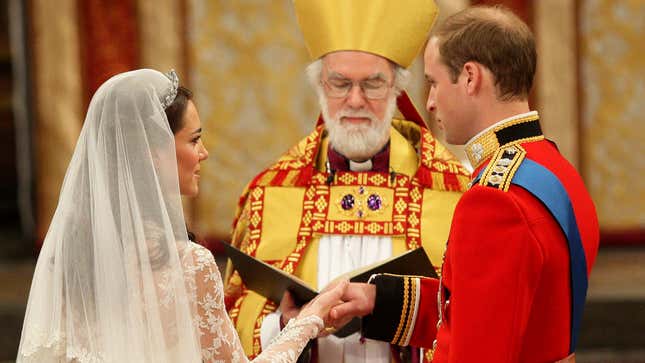

To commemorate the eighth wedding anniversary of the Duke and Duchess of Cambridge, the Kensington Palace accounts on Twitter and Instagram published a lovely photo montage. It revisits the images of the happy couple waving to adoring crowds, Union Jacks fluttering in the spring breeze. But scroll down to the responses and you’ll find skeptical reaction gifs featuring Real Housewives and Jonah Hill: references to an unsubstantiated but stubborn rumor that Will may have cheated on Kate.
Once upon a time, rumors of an affair would have been no sweat for a future king. But for the modern royal family, a very specific set of circumstances, built on both history and legacy, make this situation particularly tricky. The rumor may seem like nothing—just another instance of poorly sourced celebrity gossip perpetually burbling—but in actuality, thanks to a style of legitimacy set in the 19th century, accusations of infidelity are uniquely damaging. That’s because the modern royal family is built on the idea of a fairy tale, one that prominently features a wedding, followed by a happily ever after.
The rumor may seem like nothing—just another instance of poorly sourced celebrity gossip perpetually burbling—but in actuality, accusations of infidelity are uniquely damaging.
This latest trouble began with a strange non-sequitur of a story about Kate falling out with one of her “turnip toff” neighbors up in Norfolk, Rose Hanbury, Marchioness of Cholmondeley. The Sun suggested Kate and this woman were “rural rivals,” and Kate had banished Hanbury from her home.
An odd, vehement debunking in the Daily Mail hinted at deeper trouble, however: “I can also reveal both sides have considered legal action but, because none of the reports have been able to offer any evidence about what the so-called dispute is about, they have chosen to ignore it,” wrote columnist Richard Kay.
It doesn’t take a media lawyer to guess the planted gossip signaled the royals’ willingness to take anybody hawking more detailed rumors to court. Nevertheless, by early April, In Touch felt comfortable putting “WILLIAM CHEATS ON KATE” on their cover. And last week the story went viral, seemingly thanks to a Twitter account, Pop Alerts News, which treated the story as fact.
Now the Windsors are on the brink of a potential publicity meltdown, as unsubstantiated rumors of an affair circulate heavily on social media and begin to percolate into American gossip publications. Rumors of philandering presents a heightened danger to the Windsors, who must maintain an image of fidelity or risk jeopardizing the crown’s survival. That’s thanks, in large part, to the long legacy of Queen Victoria, who linked marital faithfulness and romantic love in royal marriage to fight for the legitimacy of the throne.
Historically, adultery only mattered for royals because kingship was determined by blood. Having a mistress was therefore simply part and parcel of having a crown. In the ancien régime, the king’s chief mistress was an official role, one with power—but not too much power!—and vital to the overall ecosystem of the court (see, for example, Madame de Pompadour). In a pinch, she could be conveniently blamed for failures or embarrassments. Ironically, Marie Antoinette might have been better shielded from court gossip if there had been a mistress to divert some of the criticism.
For the kings of Great Britain, the arrangement hasn’t been as formal. But they, too, have kept busy. After his restoration to the throne, Charles II was keen to demonstrate his royal authority— in part with legendary excesses—and so he kept enough mistresses that their likenesses dominate the Restoration room in the National Portrait Gallery. Yet monarchs stayed within an established playbook. Edward II was hustled off the throne, in large part, because of his controversially close relationship with Piers Gaveston. Gaveston was a favorite, a close companion and advisor—but there were rumors of a sexual relationship between the two men. If the relationship had remained quiet, likely no one would have cared. What caused the problems was the king elevating Gaveston to a position of immense power.
Charles II kept enough mistresses that their likenesses dominate the Restoration room in the National Portrait Gallery.
Queen Elizabeth I, of course, had many male favorites, but she kept any actual hanky-panky totally secret. In public, to maintain her power, she continued to present herself as the virgin queen. Any husband would be her superior and, therefore, threaten her position as sovereign; any signs of a sex life would demote her from ruler to mere woman.
-

-

-

-

-

-

-

-

-

-

-

-

-

-

-

-

-

-

-

-

-

-

-

-

-

-

-

-

-

-

-

-

-

-

-

-

-

-

-

-








































